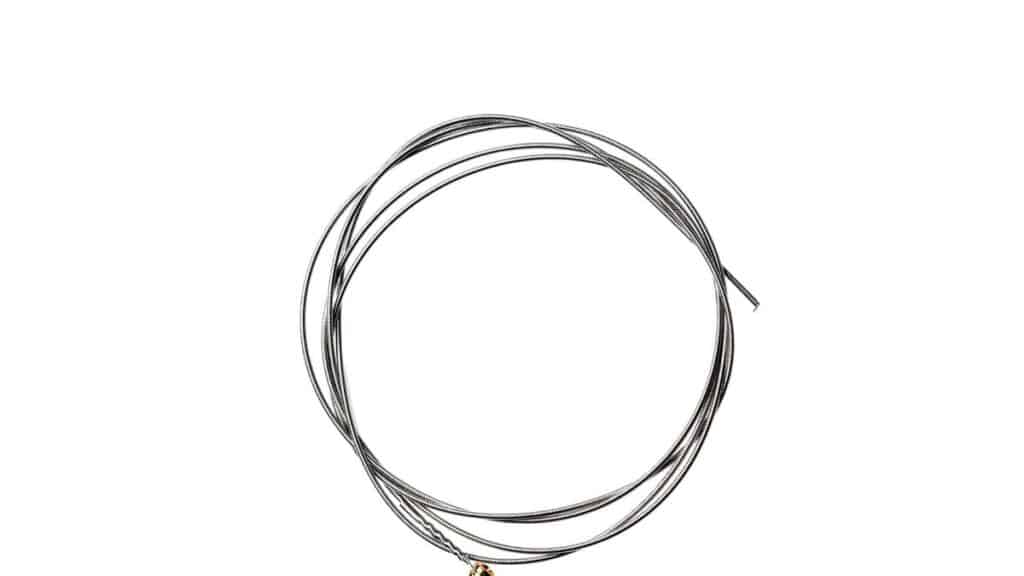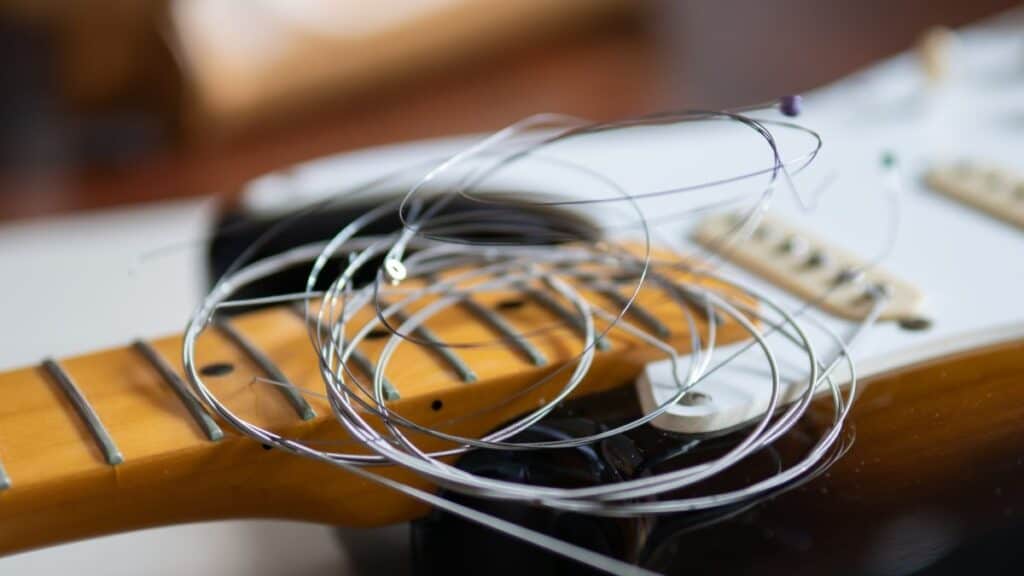Strumming on your guitar and feeling like the sound’s gone a little flat?
Well, your six-string might be in need of some fresh strings. Overlooking this small detail could be the reason your guitar doesn’t sound as good.
We are going to explore some of the most frequently asked questions and concerns when it comes to changing strings on the guitar. So, let’s begin!
How Can I Tell if My Guitar Strings Need to Be Changed?
It’s not always easy to figure out when it’s time to change your guitar strings, but your guitar gives you clues. Here are some of the signs that your guitar is ready for some new strings.

Sound Quality
First things first, you’ll notice a change in the sound. The crisp, bright, and rich tones of your guitar seem to have packed their bags and left. Instead, you’re left with dull and flat sounds that feel lackluster. It’s like your guitar just can’t hit those high notes anymore.
Tuning Stability
If you find yourself constantly battling with the tuning pegs, it might be an SOS from your strings. Old strings struggle to hold their tuning and can cause you to tweak more often than normal.
The Feel of the Strings
Are your guitar strings feeling a bit grimy or rough under your fingertips?
Aging strings collect dirt, sweat, and oil from your fingers, making them feel less smooth and more uncomfortable to play with.
Visual Check
Give your strings a good look. If you spot any discoloration, rust, or any signs of damage, like indentations from the frets, it’s definitely time to change your guitar strings.
Breakage
Last but not least, if your strings start breaking more often, it’s definitely time for a change.
Remember, these are indicators, not hard rules. Sometimes you might just feel that something is off, even if the strings look okay. Trust your gut, after all, you know your guitar best.
How Often Should You Change Guitar Strings?
Ah, the million-dollar question! How often should you change your guitar strings? If only there was a simple answer. In reality, it depends on several factors.
Frequency of Play
If you’re a daily player, strumming and picking for hours on end, you’ll wear out your strings faster than someone who only plays a few times a week.
For heavy usage, you should change your strings every month, or even more frequently, for the best possible tone.
But if you’re a casual player, you might replace guitar strings every 3 to 4 months.
Sweat and Oil
We’re all unique, and so are our hands! Some folks have more acidic sweat, which can corrode the strings faster. If you notice your strings losing their mojo quickly, your body chemistry might be the culprit. Old guitar strings will quickly accumulate sweat and oil.
Genre of Music
The style of music you play also plays a part. If you’re into heavy metal and love to bend those strings, you’ll find the need to change strings more often than a classical guitarist gently plucking away.
String Quality
All strings are not created equal. Higher-quality strings often last longer and retain their sound quality better over time. If you have coated acoustic strings, the quality may last much longer than your standard strings.
A good rule of thumb, if none of these specific conditions apply, is to change your strings every 3 months or after 100 hours of play, whichever comes first. But remember, these are guidelines, not set in stone. Keep listening to your guitar, and it will tell you when it’s time for a change.
How Long Can I Go Without Changing Strings?
Is there a limit to how long you can push those old strings? Well, in theory, you could go on until they snap, but is that really the sound you want to be making? Let’s chat about this.
Your guitar strings aren’t going to send you a polite email saying, “Hey there, would you mind swapping us out? We’re feeling a tad rusty.” But they will definitely show signs when they’ve passed their prime.
If you’re a casual player, you may be able to extend the life of your strings to about 5-6 months without drastic effects. But that’s pushing it. The quality of sound will start to degrade after a few months. The strings lose their brightness, and the rich tones become dull and lifeless.
For regular players, going beyond 3 months without changing strings isn’t recommended. In fact, professional musicians often change their strings before each performance to ensure the best sound quality.
Remember, worn out strings not only sound bad, they’re harder to play. They can cause finger discomfort and make it more difficult to stay in tune – also opening you up to having strings break during a performance.
The bottom line is that strings are a vital component of your guitar’s sound. They’re not the place to cut corners. So while there’s no strict time limit, if you want your guitar to sound its best, don’t ignore those aging strings too long.
Why is it Important to Change Guitar Strings?
The strings of your guitar are essentially the voice of your instrument. Just as you would take care of your own voice, it’s important to take care of them to keep your guitar sounding its best. Let’s unpack this a little because old guitar strings can be a buzzkill.
Sound Quality
Aged strings lose their sparkle, making your guitar sound dull and lifeless. A fresh guitar string resonates more effectively, giving you clear, rich tones. Plus, they stay in tune better, and you’ll be surprised how much that will level up your jam sessions.
Playability
As a guitar string ages, it develops corrosion from the oils, sweat, and dead skin cells from your fingers. It’s a bit icky if you think about it too much.
This leads to increased friction, which makes them harder to press down and slide on. Fresh strings are smoother, making your playing experience more enjoyable.
Intonation
Old strings can impact the intonation of your guitar, making it harder to stay in tune. This is especially true for acoustic guitars. Replacing your strings helps ensure your guitar is correctly intonated.
Maintenance
The increased tension on the guitar neck from worn, tight strings can lead to warping over time. Regularly changing your strings can help prevent this damage to your instrument.
So, you see, changing your guitar strings isn’t just a minor chore. It’s a crucial step in maintaining your guitar and your musicality. Don’t let it fall by the wayside!
Pro Tips for Making Strings Last Longer
While it’s crucial to change your guitar strings regularly, there are also some tips and tricks to prolong their lifespan and keep them sounding fresh for longer. Here’s a little toolbox of tips:
Wash Your Hands
Remember how I mentioned sweat, oil, and dead skin cells? A simple habit of washing your hands before playing can slow down that buildup, keeping your strings in better shape for longer.
Wipe Down After Playing
Using a clean, dry cloth, give your strings a quick wipe after each jam session. This will help remove any accumulated sweat and oil.
Loosen Strings Before Storing
If you’re not planning on playing your guitar for a while, consider loosening the strings to reduce tension on the neck.
Proper Storage
Keep your guitar in a case when not in use to protect it from dust and environmental factors. If possible, store it in a room with consistent temperature and humidity. Extreme changes can affect the guitar and its strings.
Use String Conditioners/Cleaners
There are products designed specifically to clean and condition guitar strings. These can help remove residue and extend string life.
Remember, these tips don’t replace the need for regular string changes. But they can help you get the most bang for your buck out of each set of strings. Make your strings last longer, and make your playing sound better – it’s a win-win!
The Process of Changing Guitar Strings
Let’s dive into the nitty-gritty, the actual process of changing your guitar strings. It may seem daunting, especially if you’re new to the world of guitars, but fear not! Once you get the hang of it, it’s as easy as riding a bike.
- Loosen and Remove Old Strings: Begin by loosening the string you wish to change. It’s best to change one string at a time to maintain the tension on the guitar neck. Once it’s loose, you can remove it from the tuning peg at the headstock and then from the bridge at the bottom of the guitar.
- Clean Your Guitar: With the string off, it’s the perfect opportunity to give your guitar a good cleaning. Wipe down the fretboard, check for any wear or damage, and clean around the tuning pegs and bridge.
- Attach New String: Take your new string and thread it through the hole in the bridge (for acoustic) or tailpiece (for electric). Pull it all the way through until the ball end of the string is secure.
- Wind String Around Tuning Peg: Lead the other end of the string up to the corresponding tuning peg on the headstock. Thread it through the hole in the peg, then start winding. Make sure the string wraps around the peg neatly, with each new wrap going below the last.
- Stretch and Tune: Once the string is securely attached and wound, give it a gentle stretch to help it settle in. Then, using your tuner, bring it up to pitch.
- Repeat: Repeat these steps for each string. It’s usually best to start with the low E string and work your way to the high E.
And voila! You’ve successfully changed your guitar strings. It may take some practice to get fast at it, but it’s an essential skill for any guitarist. Plus, there’s something really satisfying about a guitar decked out with fresh, shiny strings.
Types of Guitar Strings and Recommendations for When to Change
Now that we’ve discussed the process of changing guitar strings, it’s time to talk about the different types of guitar strings. Not all strings are created equal, and the type you choose can affect how often you need to change them.
Acoustic Strings
Acoustic guitar strings are typically made of steel and come in two main varieties: 80/20 bronze, which gives a bright, clear sound, and phosphor bronze, which provides a warmer tone. As a rule of thumb, these strings may need changing every 3 months or 100 hours of play.
Electric Strings
Electric guitar strings are made of steel as well, but are often coated with nickel. They can offer a wider range of tones, from bright and twangy to warm and smooth. Electric guitar strings may last longer due to less exposure to oils and sweat from your fingers, but a similar timeframe to acoustic strings is a good guide. Flatwound strings (also known as wound strings) have a dark mellow tone and tend to accumulate less debris and oils from playing guitar.
Classical Strings
Classical guitar strings are made of nylon and are generally warmer and mellower in tone. These strings can last longer, often up to 6 months, due to their material, but they can lose their tone faster, so listening for tonal changes is crucial.
Coated Strings
Coated guitar strings are a newer innovation in the guitar players world. These strings have a thin coating that protects them from sweat, oils, and dirt, prolonging their life. Many guitarists find that coated strings last up to 5 times longer than uncoated strings.
It’s important to note that these are just guidelines. The real indicator should be the sound of your guitar and your personal preference. If you don’t like the sound or feel of your strings, it’s time to change them, no matter what type they are.
Does the Type of Guitar Matter for Changing Strings?
Just as how a musician strikes the keys of a piano or blows into a saxophone influences the sound that is produced, the type of guitar you play also matters when it comes to changing your strings. The guitar is a sensitive creature, responsive to its environment and your touch. This means that the type of guitar you play can affect how often you need to change your strings.
For instance, electric guitars tend to be more forgiving with older strings as compared to acoustic guitars. This is because electric guitars use magnetic pickups to capture the vibration of the strings, and this mechanism is less sensitive to the degradation of the string material. The result? Electric guitar strings may not need to be changed as frequently as their acoustic counterparts.
On the other hand, acoustic guitars rely solely on the resonance of the strings with the guitar body to create sound. Any minor change in the condition of the strings can be immediately heard, thus necessitating more frequent changes.
Classical guitars, strung with nylon strings, offer a different story. These strings are less prone to the effects of dirt, oil, and corrosion but may lose their tonal quality over time. As such, they may not need as frequent changing as steel strings but should be replaced when the sound becomes dull or lacks resonance.
Remember, though, that these are just guidelines. Everyone’s experience can differ based on how often and vigorously you play, the specific brand and type of strings you use, and even the particular climate in which you live. The golden rule still applies: when your strings sound dull, lack resonance, or become difficult to tune, it’s time to swap them out.
Impact of String Quality and Material
Music, in its barest form, is vibration, and the material of your guitar strings plays a significant role in influencing this vibration. The materials used, along with the quality of the strings, can affect their longevity, meaning they have a direct bearing on how often you’ll need to be changing those strings.
Let’s start with the common materials. Steel, nickel, bronze, and nylon are the typical materials that guitar strings are made from. Each of these materials has its unique sonic characteristics and durability.
- Steel and Nickel: Steel strings, commonly found on electric guitars, are generally sturdy and less prone to damage from sweat and grime. The same can be said for nickel strings, which are favored for their bright and clear sound.
- Bronze: Bronze strings are popular for acoustic guitars due to their bright, crisp tone. However, bronze is more susceptible to the corroding effects of sweat and humidity, meaning they may need to be changed more frequently to maintain that fresh sound.
- Nylon: As for nylon strings, used primarily on classical guitars, they are less susceptible to corrosion but can stretch and wear over time, affecting the guitar’s intonation.
The quality of the string also plays a role. High-quality strings often last longer, stay in tune better, and provide a better tonal quality. Cheap strings may seem like a good deal, but they might end up costing you more in the long run if they need to be replaced more frequently.
Lastly, coated strings can be a game-changer. Coated strings have a thin layer of plastic or other material that helps protect the metal from corrosion, thereby prolonging the string’s life. While the tone may be slightly different (some players describe it as less bright), many players swear by coated strings for their durability.
Remember, changing your guitar strings regularly is part of the necessary maintenance of your instrument. It will keep your guitar sounding its best and can make your practice and performance more enjoyable.
The Effects of Not Changing Your Strings
Imagine a dapper gentleman (or lady) stepping out for an evening gala in a wrinkled suit. That’s what a guitar with old strings sounds like! We wouldn’t want that, would we? So, let’s put on our detective hats and investigate the implications of not changing your guitar strings.
- Degradation in Tone: Strings are the voice box of your guitar. When they are fresh, they sing like a nightingale, providing a bright and clear tone. However, as they age, they lose their tonal quality. Old strings can make your guitar sound dull and lifeless. Instead of a nightingale, you’re left with the croak of a raven!
- Tuning Stability: Old strings have a nasty habit of losing their tension over time. This means they may constantly fall out of tune. Imagine trying to sing a duet with someone constantly changing the key – not a harmonious experience!
- Playability: Strings naturally gather sweat, dirt, and oil from your fingers. Over time, this can make them feel less comfortable to play, kind of like trying to write with a pen full of sticky jam. It might even discourage you from playing, which would be a real tragedy!
- Potential Breakage: Strings become brittle as they age. The older they get, the higher the risk that they might snap. This could happen during a practice session, a recording, or even worse, during a live performance! The horror, the horror!
- Wear and Tear on Frets: Older strings can cause more wear and tear on your guitar’s frets. It’s kind of like old, worn-out shoes – they might still do the job, but they could be causing unseen damage.
So, as you see, not changing your guitar strings regularly is like refusing to change the oil in a classic car. It might still run, but you’re not getting the best performance, and you might be setting yourself up for problems down the road. So, keep your guitar sounding spiffy, feeling comfortable, and performing at its best by changing those strings regularly. Your guitar will love you for it!







